Hoops
Five Thoughts on Oklahoma State’s 2018 NCAA Tournament Snub
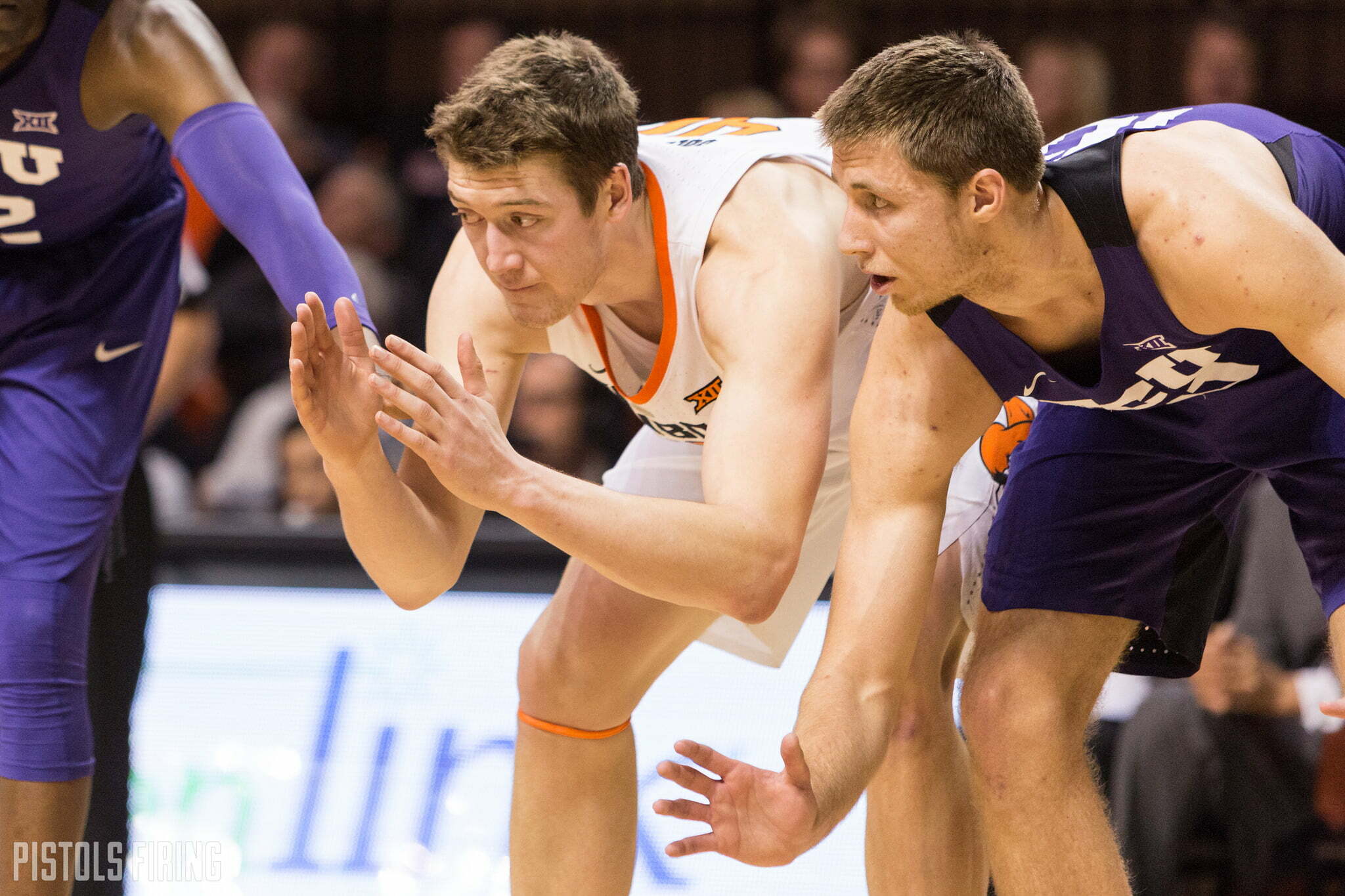
Well it happened. I thought it would, and it did. Oklahoma bypassed the play-in game, and Oklahoma State got a NIT bid (and not even a No. 1 seed!) The Pokes were left out of the 2018 NCAA Tournament, and they were not even one of the first four teams out (Baylor, Notre Dame, Saint Mary’s and USC were).
For Oklahoma State to make the Dance, the NCAA selection was going to have to take a progressive angle, which is sort of like asking Russell Westbrook to name Kevin Durant the godfather of his next child. It could theoretically happen, but everyone knows it’s not going to.
The basis for OSU’s snub was pretty easy to see coming, even if it was infuriating. Essentially, because Oklahoma State played, say, Pepperdine instead of Ball State in the nonconference portion of the schedule, it was pushed into the NIT.
Rasmussen: "In looking at games outside the conference, they had a lot of wins but they had a lot of games against teams that really were in the bottom 100 in the RPI." #okstate
— Mark Cooper (@mark_cooperjr) March 12, 2018
Here are five thoughts on Selection Sunday.
1. Justification is not real
We can talk all day about RPI, nonconference scheduling and KenPom’s external hard drive, but here’s an uncomfortable reality: Sex sells. That is, Trae Young sells. Syracuse sells. I don’t believe that there’s really ever a conspiracy against Team X, but when the details can be justified either way, it’s much (MUCH) easier to stick Trae Young in the NCAA Tournament than it is Jeffrey Carroll.
And despite seeing our little slice of the sports world through orange-colored glasses, that’s what more people want to see, too. Whether he fails or succeeds, that’s the #narrative. What I mean by justification is not real is simply this: There are so many #datapoints and statistical constructs that exist that it becomes very easy to reverse engineer a reason for getting any of about 20 teams into the NCAA Tournament. You just have to stick to the talking points.
That’s why you see the dueling justification for Oklahoma State getting left out of “well, they didn’t play enough good teams” right next to “well, they actually played too many good teams.” None of it is real. It’s all just a wall of data that people who make decisions can pull a brick from when they’re slapped on national television to give the reasoning behind their choices.
Ok State needed a LOT of games to get those quality wins. That was their problem. https://t.co/gtVi8BEWzL
— Seth Davis (@SethDavisHoops) March 12, 2018
Honestly, it’s what you and I would do, too. We see every minute of every Oklahoma State game so of course we think OSU is good enough to get in. But we didn’t watch every minute of every Arizona State or Syracuse game so we have no idea if our arguments are even valid. OSU’s statement was not emphatic (we can all at least agree on that, right?), and in the end, that meant they got left home (more on this in a minute).
2. Syracuse? OU?
But hey, since this is a sports blog we’re going to go deep on Arizona State, Syracuse and OU vs. OSU anyway. I think the committee just looked at quadrants, but in the case of Syracuse, that was a pretty iffy proposition.
| Resumes | A | B | C | D |
|---|---|---|---|---|
| Win pct. | 58% | 58% | 61% | 65% |
| Q1 pct. | 29% | 40% | 33% | 43% |
| Q2 pct. | 60% | 50% | 50% | 50% |
| RPI top 50 pct. | 41% | 43% | 36% | 67% |
| Bottom 200 pct. | 100% | 100% | 82% | 100% |
| Average RPI | 101 | 93 | 96 | 111 |
Above are the resumes of four teams. Team A is Oklahoma State, Team B is Oklahoma, Team C is Syracuse, Team D is Arizona State.
What’s interesting about the average RPI faced is that if you lop off Oklahoma State’s worst game (Mississippi Valley State), their average RPI faced falls to 94. Here’s the thing, OU played one fewer regular season game than OSU. So OSU is getting punished for playing an extra game against a bad team. Schedule better … or schedule less?
As for the other stuff, losing at Arkansas and Texas by one point each sunk the Pokes. If they had won those two, their Q1 percentage would have been 41 percent and they probably would have been in. It feels unfair to get punished for a margin that thin, but when there are 350 teams vying for 68 spots, that’s sort of what happens.
Back to Syracuse — their second best win according to RPI is Buffalo at home. Seems shaky! They also lost to two teams (Wake Forest and Georgia Tech) outside the top 150 in RPI. For the sake of context: Iowa State was not outside the top 150 in RPI. Here’s their team sheet compared to OSU.
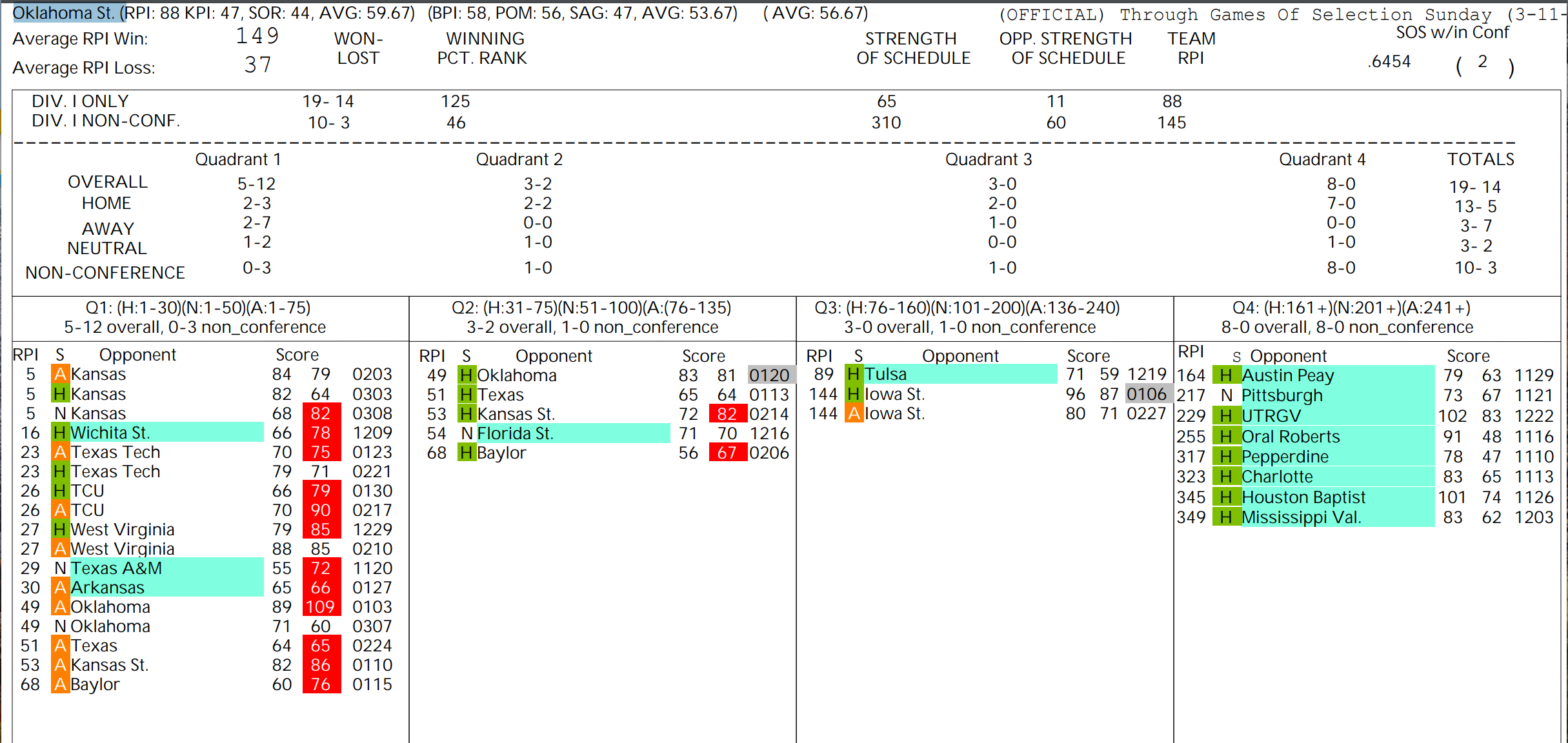
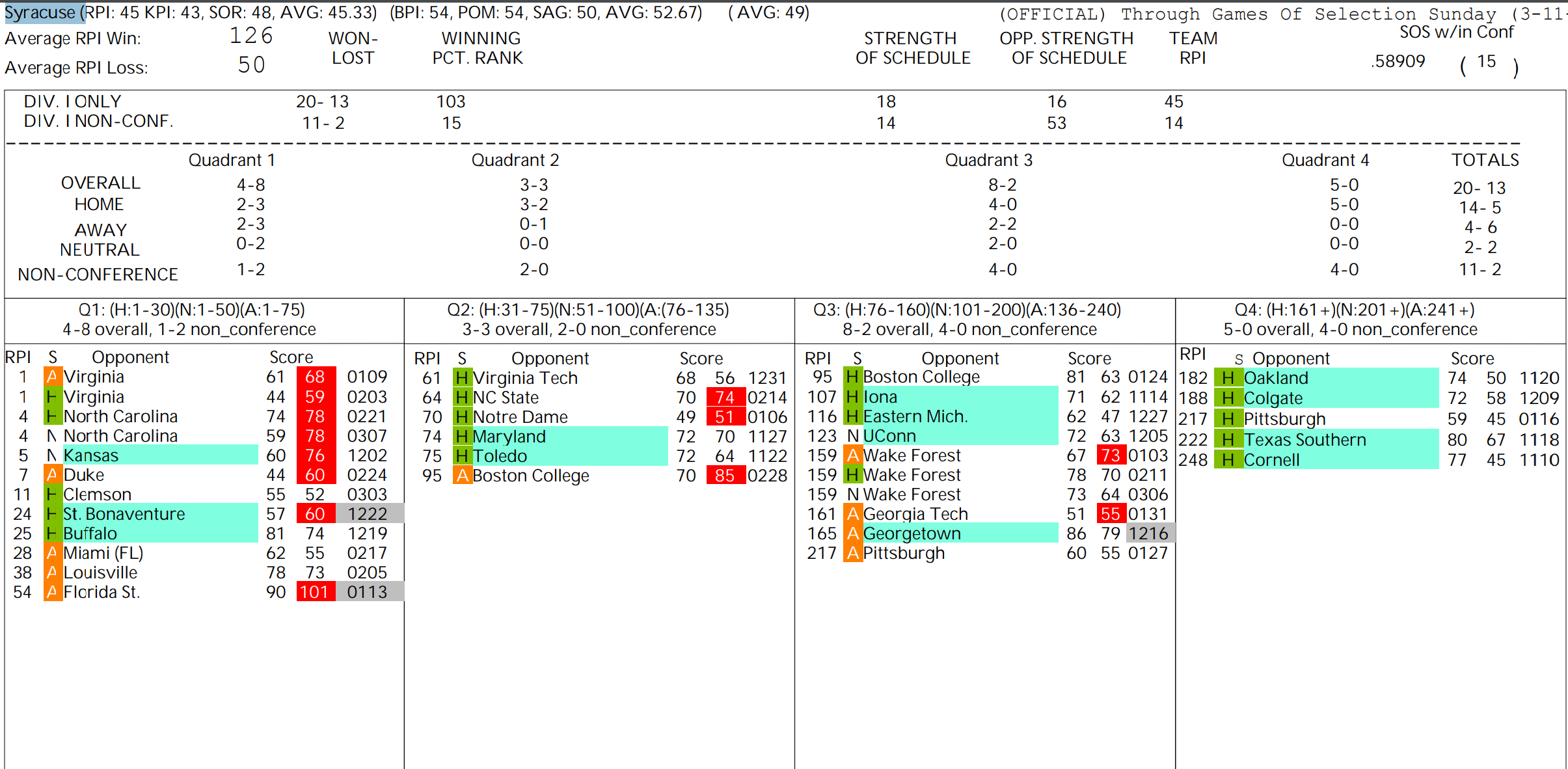
As for OU, the argument is pretty thin, too. OU had a better Q1 record (6-9 to 5-12), but … that’s about it. And they’re not even in a play-in game! OSU had a better Q2 record and no Q3/Q4 losses (OU lost to Iowa State). OU’s RPI was 49 for reasons I do not understand. OSU’s was 88.
OU’s five best nonconference games: Wichita St. (RPI No. 12), Arkansas (30), USC (34), Alabama (42), Oregon (72). OU went 2-3 in those games.
OSU’s five best nonconference games: Wichita State (12), Texas A&M (29), Arkansas, (30), FSU (54), Tulsa (88). OSU went 2-3 in those games.
None of the other nonconference games should matter. OSU won more Big 12 games than OU and beat them heads-up twice in three tries. What am I missing here? Is it because OU beat RPI No. 125 Ball State or RPI No. 168 Northwestern? Please.
Also while we’re here — for what it’s worth, even OU fans don’t think OU should have been in over OSU (that was my favorite part of the day).
Even Trae Young doesn’t think it!
Even Trae knows! https://t.co/65elg88iM4
— Pistols Firing (@pistolsguys) March 11, 2018
3. For the 100th time …
All. Sub. 150. Teams. Are. The. Same.
They’re the same!
OU beat Ball State by 40, and that’s a Q3 win, which apparently means more than OSU beating Pepperdine by 30. Can we please stop acting like the impressiveness of those wins is different by putting them in different buckets? That’s poppycock. Also, an we stop using a metric (RPI) that is influenced by what the worst teams you play do the rest of the year?
Playing the third-best SWAC team boosts your RPI significantly (if they go, say, 23-11) while playing the eighth-best does not … and yet there’s no difference between playing those two teams to a squad like Oklahoma State. One is a 25-point win. The other is a 20-point win. It’s the same thing.
Also, consider this: You would have been better off playing 24-6 Stephen F. Austin in the nonconference than 24-8 Ohio State. SFA helps your RPI more than Ohio State because they had a better record. This is 50 percent of RPI (although I can’t account for opponents’ opponents’ winning percentage — which makes up 25 percent — the other 25 percent is your own winning percentage). Bottom line: It’s madness.
OSU played a really strong set of nonconference games and also a really weak set. The average RPI of its nonconference opponents was No. 185. If OSU had simply played Yale (RPI No. 183) in place of every nonconference game, it would have had a “better” nonconference schedule. That is the definition of a broken system!
Number of tournament opponents in non conference:
K State – 1
OU – 3
OSU – 4
Syracuse – 3
St Bonaventure – 3
Arizona State – 4But sure, OK https://t.co/ii0s7CnDUe
— PFB_Nate (@PFB_Nate) March 12, 2018
4. The luck factor
When you’re on the bubble like OSU was, every little thing matters (maybe), and if nonconference scheduling/RPI are so important, then you have to get a little luck. A couple of your crappy opponents need to win their conferences (again, this is lunacy, but apparently a reality). I thought this was a really smart, interesting tweet by my guy Matt Amilian about the role luck played this year for the Pokes.
#okstate had bad luck with OOC opponents having historically bad years:
ORU: 2nd worst record since 95
Charlotte: Worst since 85
Pepp: Worst since 66
Pitt: Worst since 77
MVSU: Worst since 80— Matt Amilian (@mattamilian) March 12, 2018
5. Do more
The bottom line here is that Oklahoma State could have beaten Kansas State (twice), Baylor (twice), Arkansas and Texas. Yes, they had a fun, thrilling regular season, but everybody controls their own destiny at the start of the season, and they left it up to some pullover-wearing old men at a conference table. They don’t have anybody to point fingers at — none of us do, really — than themselves.
And look, I know all the NIT jokes — I got that Trae Young jab popped in my mentions 1,000 times tonight — but OSU has a real chance to gather some momentum going into 2019 and beyond. You know Boynton will try and take advantage, and I have a feeling his team will, too.
Today is disappointing. But if you appreciate Coach Boynton, there's one thing to do: fill GIA for the NIT for Coach Boynton and get him home to coach in the NIT. He grew up going to games in Madison Square Garden, can't imagine how special coaching in the Garden would be to him.
— Dave Hunziker (@Gopokesvoice) March 11, 2018
Mitchell Solomon on the verge of tears talking about #okstate’s future under Mike Boynton. pic.twitter.com/lTwHIno7cl
— Nathan Ruiz (@NathanSRuiz) March 11, 2018

-
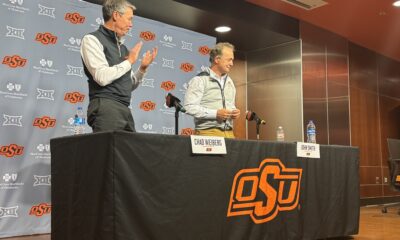
 Wrestling3 days ago
Wrestling3 days agoThe Top 5 Quotes from John Smith’s Retirement News Conference
-

 Football4 days ago
Football4 days agoWide Receiver Prospect Kameron Powell Commits to Oklahoma State
-
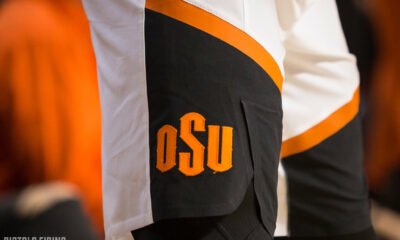
 Hoops4 days ago
Hoops4 days agoReport: Former Arkansas Guard Davonte Davis to Visit Oklahoma State
-

 Wrestling3 days ago
Wrestling3 days agoOSU Wrestling: The Impact John Smith Had on His Final Boss, Chad Weiberg






